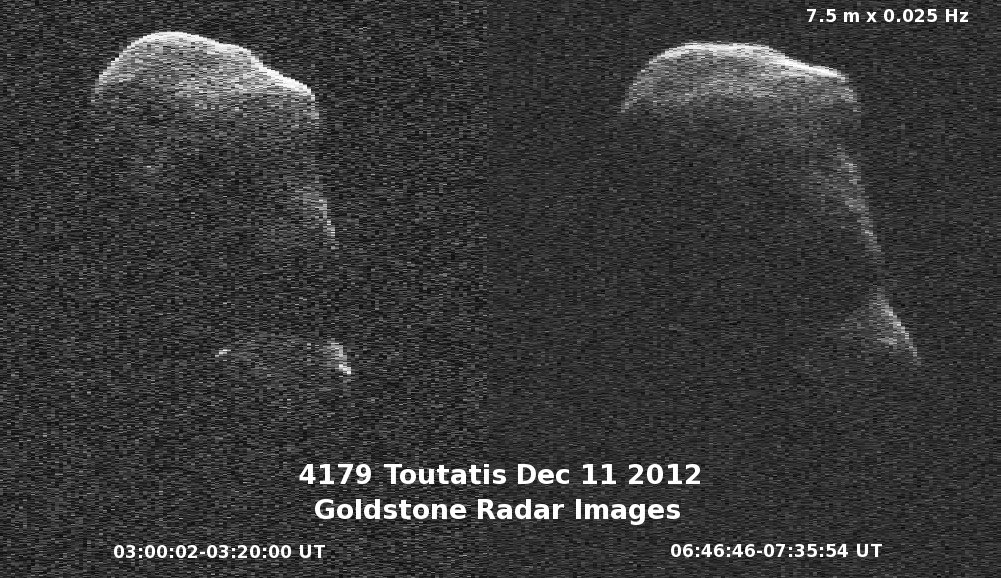Goldstone delay-Doppler radar images of Toutatis from December 11, 2012. Credit: NASA
While Asteroid 4179 Toutatis was never a threat to hit Earth during its quite-distant pass on Dec. 11-12, astronomers were keeping their instruments and eyes on this space rock to learn more about it, as well as learning more about the early solar system. Even at closest approach, 4179 Toutatis was 7 million km away or 18 times farther than the Moon. But that is close enough for radar imaging by NASA's Goldstone Observatory, which has recently upgraded to a new digital imaging system, as well as optical imaging by other astronomers. Already, there are some preliminary findings from this 4.5-kilometer- long (3-mile-long) asteroid's flyby.
"Toutatis appears to have a complicated internal structure," said radar team member Michael Busch of the National Radio Astronomy Observatory. "Our radar measurements are consistent with the asteroid's little lobe being ~15% denser than the big lobe; and they indicate 20% to 30% over-dense cores inside the two lobes."
NASA says this raises the interesting possibility that asteroid Toutatis is actually a mash up of smaller space rocks. "Toutatis could be re-accumulated debris from an asteroid-asteroid collision in the main belt," Busch said. The new observations will help test this idea.
Here are more images and video from Toutastis' pass:
Adam Block from the Mount Lemmon SkyCenter/University of Arizona captured this footage:
Toutatis from Adam Block on Vimeo.
Astronomers are getting to know this asteroid, as it passes by Earth's orbit every 4 years. It is one of the largest known potentially hazardous asteroids (PHAs), and its orbit is inclined less than half-a-degree from Earth's. No other kilometer-sized PHA moves around the Sun in an orbit so nearly coplanar with our own. This makes it an important target for radar studies.
The team from the
Remanzacco Observatory
took this 120-second image of Toutatis:
Image from the ITelescope network (Nerpio, Spain) on 2012, Dec. 11.9, through a 0.15-m f/7.3 refractor + CCD. Credit: Ernesto Guido and Nick Howes/
And this was a fairly close pass for Toutatis: The next time Toutatis will approach at least this close to Earth is in November of 2069 when the asteroid will fly by at a distance of only 0.0198 AU (7.7 lunar distances).
NASA's Goldstone radar in the Mojave Desert has been "pinging" the space rock every day starting on December 4, and will continue until the 22nd. The echoes highlight the asteroid's topography and improve the precision with which researchers know the asteroid's orbit.
Additionally, the Chinese Chang'e 2 spacecraft will be observing Toutatis tomorrow, on December 13, 2012 Chang'e 2 was originally launched to study the Moon but after completing its mission, Chang'e 2 departed from the L2 point in April 2012 to align itself to make a flyby of 4179 Toutatis, expected to take place at approximately 08:27 UTC on December 13.
"We already know that Toutatis will not hit Earth for hundreds of years," said Lance Benner of NASA's Near Earth Object Program.. "These new observations will allow us to predict the asteroid's trajectory even farther into the future."
Animation from Ernesto Guido and Nick Howes of 40 consecutive 10-second exposures. Credit: Ernesto Guido and Nick Howes/
NASA says the asteroid is already remarkable for the way that it spins. Unlike planets and the vast majority of asteroids, which rotate in an orderly fashion around a single axis, Toutatis travels through space "tumbling like a badly thrown football," as Benner describes it. One of the goals of the radar observations is to learn more about the asteroid's peculiar spin state and how it changes in response to tidal forces from the Sun and Earth.
Here's an animation of Asteroid Toutatis compiled the live broadcast from the
Slooh space camera team
:
Goldstone delay-Doppler radar images of Toutatis from December 11, 2012. Credit: NASA
Sources:
NASA
,
Remanzacco Observatory,
Chang'e 2 mission
 Universe Today
Universe Today
